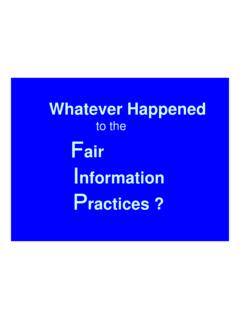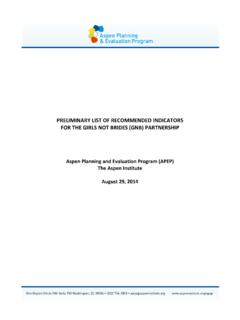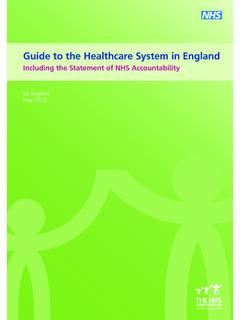Transcription of Guidance for Assessing Pesticide Risks to Bees - …
1 Guidance forAssessing Pesticide Risks to bees Office of Pesticide ProgramsUnited states environmental protection agency Washington, 20460 Health Canada Pest Management Regulatory agency Ottawa, ON, Canada California Department of Pesticide Regulation* Sacramento, CA *Currently, due to resource limitations, the California Department of Pesticide Regulation does not conduct full ecological risk assessments, but reserves the right to do so in the future. June 19, 2014 2 Executive Summary This document provides Guidance to risk assessors for evaluating the potential risk of pesticides to bees , particularly honey bees (Apis mellifera). This Guidance is not limited to identifying the risk assessment process but includes consideration of the underlying data on which the process is based.
2 For purposes of brevity, this Guidance refers to the White Paper in Support of the Proposed Risk Assessment Process for Bees1 submitted to the Federal Insecticide, Fungicide and Rodenticide Act (FIFRA) Scientific Advisory Panel (SAP) for review and comment in September 2012. The White Paper describes the basic framework of the risk assessment process and the data used to inform the various tiers of refinement that may be required to support risk management decisions. This Guidance also considers recommendations2 provided by the FIFRA SAP in response to the White Paper, where such recommendations can be immediately implemented. Additional recommendations from the FIFRA SAP that cannot be implemented at this time, because the science supporting such efforts has not been sufficiently vetted, will be considered as the science evolves.
3 The risk assessment process described in the White Paper identifies a tiered approach where data are collected on individual bees that are representative of different life stages (larval/pupal versus adults) and castes ( , worker bees ). While additional data may be available on other bee species and these data can be included in the tiered risk assessment process as an additional line of evidence, the primary process relies on honey bee data as a surrogate for both Apis and non-Apis bees . In this process, laboratory-based studies of larval/pupal and adult honey bees provide data on individual bees that can be used as a surrogate for other species of bees , including solitary species.
4 At the semi-field and full-field levels, studies of the colony can be used to represent effects to honey bees themselves and as a surrogate for other social bees . An advantage of using honey bees is that the husbandry and life cycle of the species and its significance in pollination services is well known and test protocols are available. As the science evolves, methods and studies using non-Apis bees may be considered and incorporated into the risk assessment. The risk assessment process for bees is consistent with that used for other taxa, as described in the Overview Document3, in that it consists of three phases ( , problem formulation, analysis, and risk characterization) and it is tiered.
5 The first tier consists of a screening-level risk assessment that is intended to be sufficiently conservative such that chemicals that pass the screen are considered to represent a relatively low risk of adverse effects to bees . For those chemicals which do not pass the initial screen, refinements in exposure estimates and/or mitigation measures may sufficiently reduce risk quotients (RQs) below levels of concern (LOCs) such that further refinements are not needed. For chemicals where RQ values still exceed LOCs and, depending on risk management needs, additional refinements in exposure and/or effects estimates can be made based on studies with increasing levels of environmental realism.
6 Although approaches for estimating exposure and effects differ across aquatic and terrestrial systems as well as between plants and 1 USEPA. 2012. White Paper in Support of the Proposed Risk Assessment Process for bees . Submitted to the FIFRA Scientific Advisory Panel for Review and Comment September 11 14, 2012. Office of Chemical Safety and Pollution Prevention Office of Pesticide Programs environmental Fate and Effects Division, environmental protection agency , Washington DC; environmental Assessment Directorate, Pest Management Regulatory agency , Health Canada, Ottawa, CN; California Department of Pesticide Regulation #!
7 DocumentDetail;D=EPA-HQ-OPP-2012-0543-00 04 2 USEPA 2012. Final FIFRA SAP Pollinator Meeting Report. SAP Minutes No. 2012-06. A Set of Scientific Issues Being Considered by the environmental protection agency Regarding Pollinator Risk Assessment Framework. September 11 14, 2012, FIFRA Scientific Advisory Panel Meeting. #!documentDetail;D=EPA-HQ-OPP-2012-0543- 0047 3 USEPA. 2004. Overview of the Ecological Risk Assessment Process in the Office of Pesticide Programs, U. S. environmental protection agency . Endangered and Threatened Species Effects Determinations. Office of Prevention, pesticides and Toxic Substances Office of Pesticide Programs, Washington DC. January 23, 2004. 3 animals, the basic process of moving from a screening-level assessment with conservative assumptions to more refined measures of exposure and effects is consistent across taxa.
8 The Guidance follows the generic structure of the risk assessment process, as described in the White Paper and Overview Document. While this Guidance is not intended to be exhaustive, it provides staff with sufficient information with which to ensure consistency in ecological risk assessments written in support of new and existing Pesticide registration decisions. The different levels of refinement described in the Guidance are not intended to be prescriptive; the specific set of data used in Assessing potential Risks of a Pesticide to bees ultimately depends on multiple lines of evidence and risk management objectives. 4 Acknowledgement The following individuals and organizations contributed to this Guidance document: environmental protection agency Office of Pesticide Programs (OPP) Rueben Baris Joseph DeCant Frank Farruggia Kristina Garber Anita Pease Keith Sappington Mah Shamim Thomas Steeger Allen Vaughan Christina Wendel Health Canada Pest Management Regulatory agency (PMRA) Connie Hart Wayne Hou California Department of Pesticide Regulation (CALDPR) Richard Bireley 5 Contents 1 Overview of Pollinator Risk Assessment Process.
9 6 Foliar Spray Applications .. 6 Soil Application and Seed Treatment .. 10 2 Problem Formulation .. 13 3 Analysis Phase .. 15 Exposure Characterization .. 15 Tier I Exposure Estimates .. 15 Refinements of Tier I Exposure .. 16 Effects Characterization .. 19 USEPA Toxicity Testing Requirements for bees .. 19 Additional Guidance for USEPA Pollinator Testing .. 19 PMRA Toxicity Testing Requirements for bees .. 21 Tier I Effects Characterization .. 22 Tier II Effects Characterization .. 24 Tier III Effects Characterization .. 27 4 Risk Characterization .. 31 Risk Estimation .. 31 Calculation of Risk Quotients for Tier I Risk Assessment .. 31 Levels of Concern for Tier I Risk Assessment.
10 32 Risk Description .. 33 Use of Other Lines of Evidence .. 33 Synthesis of Risks among Tiers .. 34 Risk description on Sublethal Effects .. 35 Use of Simulation Models .. 36 Uncertainties .. 36 Data Gaps .. 40 Appendix 1. Conceptual Models .. 42 Non-systemic, Foliar Spray Applications .. 42 Systemic, Foliar Spray Applications .. 43 Systemic, Seed 44 Systemic, Soil Application .. 45 Appendix 2. Considerations related to quantifying residues of pesticides in pollen and nectar using Pesticide -specific studies .. 46 Appendix 3. Bee REX .. 48 Appendix 4. Tier 3 Field Study Design Considerations .. 57 6 1 Overview of Pollinator Risk Assessment Process This section summarizes the overall risk assessment process for characterizing the Risks of pesticides to honey bees (Apis mellifera), which are used as a surrogate species for other Apis and non-Apis bees and other insect pollinators.



















